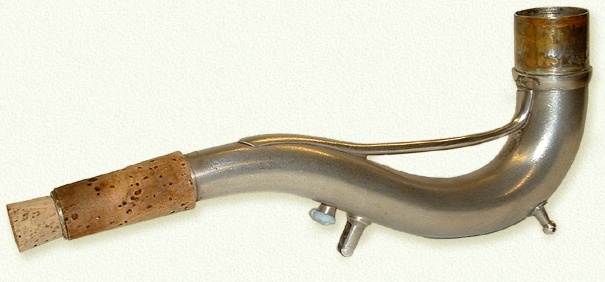

Cleaning saxophone crooks/necksWhilst the craft of sax repair undoubtedly consists of a motley collection of arcane skills, unusual tools and noxious potions, there are a number of highly effective techniques that are nothing more than plain old-fashioned housekeeping - and if there's a surefire way to rejuvenate a grubby old horn it's to give its crook (or neck) a really good clean.It really doesn't take long for crud to build up in this part of a horn, but no matter how fastidious you are with mopping the thing out you can't really do much to prevent scale forming - which shows itself as little whitish grey deposits. Even if there isn't any scale there's often a film of grease and fat and assorted other nasties that get left behind after a normal clean out. So here's a safe and simple way of restoring a bit of sparkle to
the bore of the crook - and thus to your tone.
Vinegar is ideal for this job. It's a weak acid - just about strong
enough to soften or dissolve calcium carbonate (scale) and weaken
the grip of fats and grease, but certainly not strong enough to
do any harm to the metal or the finish on the horn - at least not
unless you have a spare couple of weeks and a great deal of vinegar.
It also acts in an anti-microbial fashion and is an effective agent
for reducing the risk of contamination
from the various bugs that thrive in the warm and wet environment
of the crook's bore. The first thing you'll need to do is remove the octave key. You now have a 'bare' crook. You now need to stop up the mouthpiece end. I use a small cork,
which is ideal if you have such a thing lying around, but if not
you'll just have to improvise. You can use a large lump of blu-tack,
or plasticine...or even a potato or piece of apple! All you really
need is something that's going to be watertight for half an hour
or so. Clingfilm might work, but I find the vinegar often seeps
out over the cork and leaves it smelling a bit. If you really want to go the whole hog you can warm the vinegar
before pouring it into the crook. I find this helps the cleaning
process and speeds it up. For lacquered crooks I wouldn't heat the
vinegar to anything more than 'hand hot'...i.e. you can place a
finger in the heated vinegar and hold it there with no discomfort. While the vinegar's heating, consider how you're going to prop
the crook up. It's got to stand for about half an hour and hold
the vinegar in, so you need some way to support it. I have a very
special tool for this - it's called 'a plate'. Yep, I just pop the
pillars up on a plate and the crook sits there quite happily. Tenor
crooks will need a slightly steeper angler because of that air gap
(two plates). So, fill the crook with the vinegar (hold it by the mouthpiece
cork if using hot vinegar) and pop it down to rest. When the time comes to pour out the vinegar you might like to pour
it into a cup. There's no real reason for doing this other that
it might give you a small sense of satisfaction as you note just
how dirty the vinegar looks (certainly works for me!). Refitting the key is easy enough - poke the tenon through the 'ring'
of the key and lift the key up and over the crook...being careful
not to let the spring scratch the crook surface. The crucial part
is to ensure that the spring seats on the little channel on the
top of the crook. If the spring is loose, tighten up the screw a
little (it's only small, so don't overdo it). Doesn't hurt to wipe
the spring over with a little oil to help prevent it rusting...and
pop a small drop of oil on the rod screw before you refit it. If
you have a spare pipecleaner, clean out the key barrel beforehand...and
give the screw a wipe too. If there's one drawback to this method it's that the extreme tip of the crook might not get cleaned, due to the bung preventing the vinegar reaching it (though I generally find that some vinegar always manages to seep right to the end of the tip). You can either wipe a little vinegar in the tip before you pop the bung in, or you can coat the last centimetre or so of the mouthpiece cork liberally in vaseline and simply up-end the crook in a centimetre of cold vinegar for half an hour or so. If the job's been a success you should be able to see that the bore of the crook is nice and clean. It won't be bright and shiny (as I I said as the start, vinegar simply isn't that powerful), but it should be free of those whitish/grey deposits. If not, repeat as necessary. If you really must leave the octave key on I'd advise thoroughly
wrapping it up in clingfilm, being very careful with the washout
procedure, and leaving it wrapped until the last washout is complete...and
giving the screw and spring a good oil afterwards, just in case. |
If you've enjoyed this article or found it useful and would
like to contribute
towards the cost of creating this independent content, please use the button
below.
 What you need now is a sufficient quantity of vinegar to fill the
crook. If you're frugal like me (or just a plain cheapskate...or
the sort of person likely to curse me when you find yourself looking
at a fish supper...and no vinegar) fill the crook up with water,
then tip the water into a cup, then tip the water out and replace
it with that amount of vinegar.
What you need now is a sufficient quantity of vinegar to fill the
crook. If you're frugal like me (or just a plain cheapskate...or
the sort of person likely to curse me when you find yourself looking
at a fish supper...and no vinegar) fill the crook up with water,
then tip the water into a cup, then tip the water out and replace
it with that amount of vinegar.